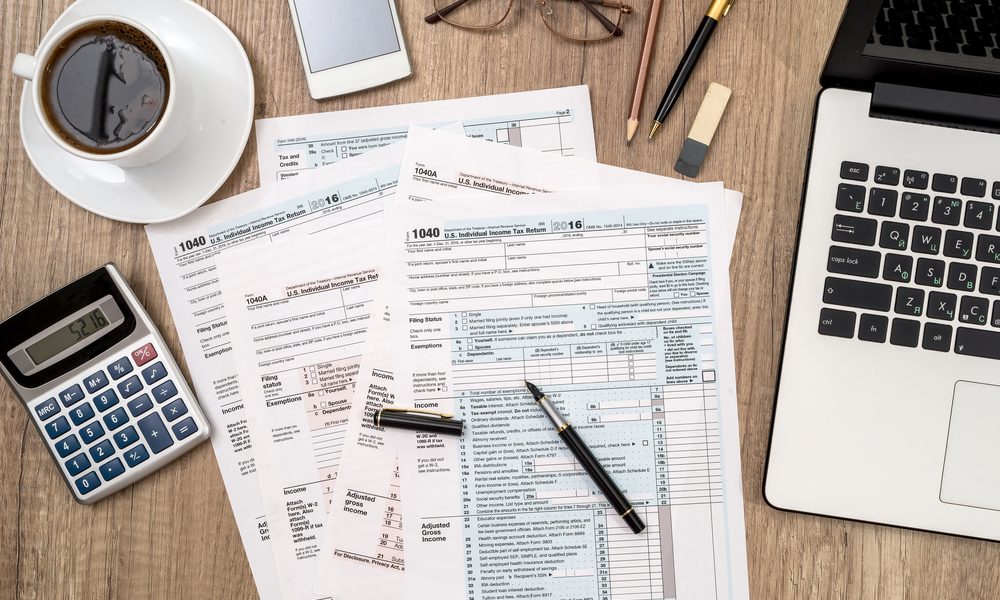Based on pressure from Congress and an IRS Advisory Council opinion released last November, the IRS may soon raise the current $1,200 tax reporting threshold for slot machine jackpots to $5,800. It hasn’t happened yet, but there’s more optimism today than at any time in the last decade. That would be one small improvement in the onerous IRS regulations about gambling. But it could also present a few challenges.
 First some background about the evil IRS regs that plague gaming. Did you know that if you made a $5 wager on a video slot machine game, and you won a very small $20 payout that you are required by federal law to report that $20 amount as income on your tax form? Using some bizarre logic, the tax collectors say you can’t even deduct your initial $5 bet from that amount, even though you only “won” $15!
First some background about the evil IRS regs that plague gaming. Did you know that if you made a $5 wager on a video slot machine game, and you won a very small $20 payout that you are required by federal law to report that $20 amount as income on your tax form? Using some bizarre logic, the tax collectors say you can’t even deduct your initial $5 bet from that amount, even though you only “won” $15!
Not to worry. No player in recorded casino history has ever reported those small wins as the law requires. So why haven’t millions and millions of these blatant tax cheats been locked up behind bars like Al Capone, Chuck Berry and Pete Rose?
Perhaps it’s because the current tax laws related to gaming are considerably different from the ones related to mobsters, musicians and athletes. The IRS’ set of rules about gambling are out-of-date, unrealistic, and just plain ridiculous.
As mentioned above, the government only requires casinos to officially report players’ winnings to the IRS when they hit a magic number of $1,200. Thus, players have adopted the unwritten rule: “if they can’t catch you, don’t tell ‘em”. Normally, that would seem to be terribly unpatriotic; but, as mentioned, the current tax laws are a joke.
Let’s begin with the $1,200 tax reporting threshold. That number was established in 1977. Forty-seven years ago, Nevada was the only state with legalized casino gambling, and the township of Atlantic City, NJ was still a year away from opening their first casino. There were only a handful of Native American bingo halls, and it would be years before they converted those locations to house slot machines.
According to Amortization.com, $1,200 in 1977 would be the equivalent of $6,324.66 in today’s dollars. If you did the calculations backwards, today’s reporting limit would be just $228 back in ‘77. In other words, it is absurdly too low now.
But it isn’t just inflation that has changed. Slot machines and their average bet numbers have grown as fast as, or faster than, inflation. In those days, a three-coin $1 slot would be in the high limit room. Today, the max bet on most 1¢ machines is rarely as low as $3.
Payouts of $600, $1,000 and $1,199 were considered big wins in 1977. Jackpots above that level did happen, but not too often. In a 100-day survey performed in 2014 at a leading southern California casino, 86% of all jackpots paid were between $1,200 and $5,000. In a recent survey in the Southeast U.S., the number exceeded 90% of all jackpots. That’s not surprising since today’s bonus-rich penny games are designed with higher awards across the paytable.
In my consulting business, many clients have been questioning why the ratio of $1,200 and greater jackpots compared to Coin In has been rapidly increasing in the last few years. The explanation is seldom fraud, but it is instead the changing nature of today’s slots.
Dan Retzlaff of the analytic firm ReelMetrics attributes these shifts to:
- An increase in average bets
- A higher percentage of play on leased games (premium categories)
- The popularity of higher bet games (like the #1 Dragon Link)
- Players chasing larger jackpots
- The impact of influencers seen playing max and hitting large jackpots
He also notes, “Be prepared for this trend to continue. Slots in Australia today are now featuring many games with a ‘jackpots only’ configuration. Historically, what works there moves to the U.S. within a year or two.”
The folks at Eilers & Krejcik Gaming/Fantini Research are also noticing the trends toward higher payouts. Just last month they added a new tab to their monthly reporting tool to separate $0.05 and $0.10 games from the Low Denomination category. The report lists some of the most popular games that now fall in this higher bracket, and they all have higher potential bonus round payoffs that easily hit $1,200.
Why should operators care about the reporting limits? It has to do with customer satisfaction. Current regulations require machines to “lock up” at the $1,200 mark. The player can no longer play the machine and must wait until an attendant arrives to reset the game. It also triggers a wave of time-consuming paperwork that includes a W-2G, presentation and verification of ID, and an examination of play patterns to see if any “money laundering” thresholds have been hit. This process and the delays often change a guest’s mood from elation to irritation.
Slot System technology has provided some relief with “accumulated W2G processing” (saving the ID step), and a “key-to-credit” feature which reduces cash handling. But these are only band aids and not a cure.
The threshold is the real problem. Nevada’s Democratic Representative Dina Titus has been working with Pennsylvania Republican Guy Reschenthaler to urge the IRS to change the limit. She has nearly a decade fighting for this issue without much luck. These days, it seems impossible for anything to go forward in the House, even with bipartisan support. However, 24 additional members of Congress have now joined the cause. They have written to IRS Commissioner Danny Werfel urging him to adopt the Advisory Council’s opinion and change the threshold without the passage of any new legislation. That would be the best solution by far. At least it would be great for players. And casino owners are certain to see a corresponding increase in profits.
The change is seemingly a win/win. But are there some downsides? When the industry switched from coin/tokens to tickets and credit meters in the mid- to late-‘90s, there was a general loss of “jackpot celebrations”. A $600 win pre-TITO was announced with a loud cacophony of tokens landing in the bottom of noisy stainless steel coin trays. Today, these same payouts go silently to a credit meter, albeit with some short electronic sound effects. But it’s not the same.
Today’s $2,000 win locks up the machine, often with an electronic sound that continues until reset by the attendant. Nearby players witness the cash payoff (this can also be a negative for those wary of flashing cash) and the slot attendants circling the game.
It will be critical for both manufacturers and operators to make sure that wins in the $1,200 to $5,000 range are still recognized in some public manner.
A more serious risk is that personal service could decline, despite the elimination of the play interruptions. In that 100-day survey mentioned above, nearly 50,000 jackpots were hit, or an average of 500/day. Each of those involved a slot attendant working with the player to unlock their machine, do the paperwork and pay the jackpot in cash. When a $1,200 to $5,000 jackpot hits, the player is generally in a great mood and has a handful of cash. It is absolutely the best opportunity for workers to gain a tip. And those gratuities often exceed the total hourly pay at many casinos. A loss of these income opportunities could lead to increased turnover, difficult recruitment and declining team morale.
An informal survey with slot operators this month indicated that most were hugely in favor of the new limit. But they were concerned about the issues cited. Additionally, in the short term, they noted that techs would have to reset every machine to accept the new levels, forms would have to be reprinted, systems would require a software update and new procedures would have to be written, approved, and adopted.
Commenting on the record, Frank Legato, editor at Global Gaming Business, thought there could be a mid-step in adopting the new limit: “I would leave the (machine) lock-up at $1,200, at least temporarily, to preserve the tip opportunities for slot techs and attendants. Presumably, they would only have to quickly verify a jackpot over $1,200, or $2,000 or $3,000—whatever the casino sets as its policy (eliminating the paperwork). Perhaps this extra step can be phased out over time.”
He, like several slot directors, wondered if the slot systems could create an automated optional tip pool for JPs below the $5k limit. But he also said, “better yet, pay the attendants more—a living wage that would not require supplementing through gratuities. From my view, that’s the only solution that truly makes sense.”
At first take that sounds ideal, but it would more than double current labor costs. However, with a reduced workload (remember the 500 daily transactions mentioned that would not be required), the total labor cost could remain constant even as profits grow.
While not going on-the-record, other slot directors liked this approach: “You will need less jackpot processing staff when 80% (or more) of your jackpots no longer require intervention. We have been working to move our best players onto a self-pay system and have surprisingly seen no negative impact on our tipping positions. I think the attrition of staffing to the proper levels will also help once the dust settles.”
Almost every slot director, and 100% of the manufacturers, thought the increased level (whether it is $5,000, or the $5,800 suggested by the IRS Advisory Council) couldn’t come soon enough. Many cited their high limit players who hit the $1,200 mark almost every few minutes. It is not uncommon for those players to have two or more machines locked up at the same time waiting for payoffs. With the new limits, the credit meter would absorb the new jackpots (<$5k) without a lockup. Legato, who is also an avid slot player, summed it up best saying, “The convenience factor alone makes this a welcome change.”
One final note about justifying all those “tax cheats” not reporting their smaller wins, consider this example:
- A couple enters the casino with $200 to spend on an evening’s entertainment. Playing slots, they hit a $1,200 jackpot. But having fun, their money quickly goes back in until they hit another $2,000 win. They finish their evening with some small hits, but eventually put all their winnings back into the machines. They didn’t terribly mind the loss of $200, since they had a full evening of fun.
Now the ridiculous tax code comes into play. Not only can’t you deduct the $200 loss, but you owe taxes on the $3,200 that you no longer have.
Worse, you are guilty until you can prove you are innocent. There’s no clause in the Constitution that protects you from the IRS. All the legal precedents about the prosecution’s “burden of proof” don’t apply to the tax man.
With a lot of time and effort, you can ease most of your tax burden. You must maintain an accurate diary of win/losses with times and amounts documented. You also need proof of your spending through checks or cash advances made at the casino. Finally, you need a win/loss statement from the casino’s automated tracking system. If you didn’t use your player’s card, you are out of luck.
Unfortunately, many players have learned the hard lesson that the automated win/loss statement by itself won’t satisfy the auditors.
Some good news is that the rate of audits has declined in recent years due to budget cutbacks and IRS staffing shortages. The bad news is the Government Accountability Office (GAO) reports: “From fiscal years 2010 to 2021, the majority of the additional taxes IRS recommended from audits came from taxpayers with incomes below $200,000.”
Bottom line: say your prayers that the IRS changes the jackpot reporting limit soon, and operators find a way to mitigate the tips issue and manage to still celebrate winning.
# # #
NOTE: An excellent source of gaming tax information for players, including what to record and what not to record, is in the book: “Tax Help For Gamblers,” which we reviewed in March of 2019. Read the review here.





